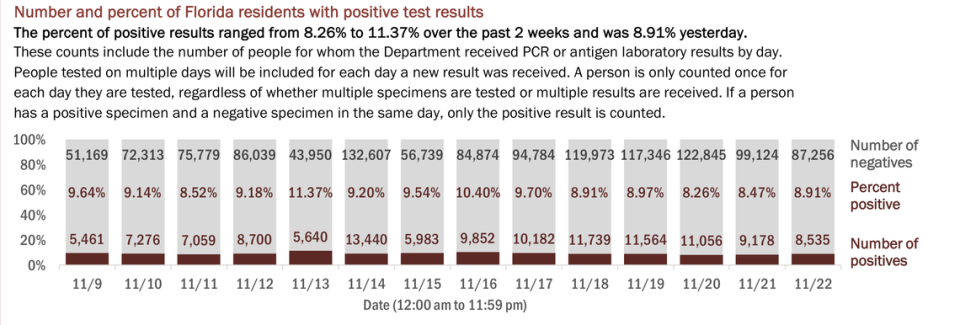Florida COVID-19 resident death toll hits 18,000 and state adds 6,331 confirmed cases
Florida’s Department of Health on Monday confirmed 6,331 additional cases of COVID-19 as dozens of Florida counties have hit a “tipping point” of infections just a few days before Thanksgiving, according to Harvard University data.
Also, the state announced 94 COVID-19 related resident deaths, bringing the resident toll to 18,085.
Florida now has a total of 944,745 confirmed cases, the third highest number of total confirmed cases in the country after Texas and California, according to the New York Times COVID-19 database.
Two new non-resident deaths were also announced, bringing the non-resident toll to 225.
Listen to today's top stories from the Miami Herald:
Subscribe: Apple Podcasts | Spotify | Amazon Alexa | Google Assistant | More options
Confirmed COVID-19 cases in South Florida
Note: The Florida Department of Health says that each county’s percent positivity for new cases (people who tested positive for the first time) does not include retests (people who have tested positive once and are being tested for a second time).
▪ Miami-Dade County reported 1,499 additional confirmed cases of COVID-19 and 16 new deaths, according to Florida’s Department of Health. The county has a total of 216,442 confirmed cases and 3,782 deaths. Percent positivity for new cases decreased from 8.01% to 7.15%. The 14-day percent positivity average was 8.23%, according to Miami-Dade County’s “New Normal” dashboard.
▪ Broward County reported 688 additional confirmed cases and three new deaths. The county now has a known total of 101,747 cases and 1,629 deaths. Percent positivity for new cases increased from 6.21% to 6.36%.
▪ Palm Beach County saw 502 additional confirmed cases and 11 new deaths. The county now has 62,278 confirmed cases and 1,659 deaths. Percent positivity for new cases had a slight increase from 6.41% to 6.42%.
▪ Monroe County confirmed 26 additional cases and no new deaths. The county has a known total of 3,140 cases and 27 deaths. Percent positivity for new cases increased from 8.36% to 9.26%.
Is Florida seeing a COVID-19 spike?
Florida’s single day case counts have hit levels not seen since August several times this month, and COVID-19 related hospitalizations are seeing an uptick. Cases are also increasing across the country, and researchers at the Harvard Global Health Institute have created a map to visualize the COVID-19 risk by state and county using the seven-day average of new cases per 100,000 people.
Based on the map, at least 47 of Florida’s 67 counties are in the “red” zone, including Miami-Dade, Broward, Monroe and Palm Beach counties. This means the counties are at a “tipping point” and that stay-at-home orders are “necessary” to control the spread, according to the university.
And as more states continue to see a spike in cases, the Centers for Disease Control and Prevention is recommending people avoid traveling during Thanksgiving to reduce the risk of COVID-19 spreading. COVID-19 concerns have also pushed colleges and universities across the country, including in Florida, to move classes online after the holiday.
COVID-19 hospitalizations in Florida
One of the tools that officials rely on to determine whether the coronavirus situation is improving in the state is hospitalization data. Unlike testing, which might be limited or takes days to report results, hospitalizations can help give officials a real-time snapshot of how many people are severely ill with COVID-19.
The Florida Agency for Health Care Administration reports the number of patients hospitalized statewide with a “primary diagnosis of COVID.” The data, which is updated at least every hour, does not distinguish between the number of COVID-19 patients in hospital intensive care units and those in acute-care beds, which require less attention from nurses.
Previously, the state was providing only the total number of hospitalizations in its statewide and county-level data. Miami-Dade was an exception, with hospitals self-reporting a number of key metrics, including hospitalizations, to the county, which has made this data public for several months.
As of 3:16 p.m. Monday, there were 3,758 COVID-19 patients admitted into hospitals throughout the state, according to the Florida Agency for Health Care Administration dashboard. This is a big jump from what the state was reporting last month though it’s still less than early August, when more than 5,000 COVID-19 patients were admitted into hospitals throughout the state.
Of Monday’s hospitalizations, 532 were in Miami-Dade, 382 in Broward, 264 in Palm Beach and eight in Monroe, according to the agency.
Florida’s current hospitalization data does not always match the hospitalization data reported in Miami-Dade’s “New Normal” dashboard. Officials say this could be for a number of reasons, including the frequency of daily updates.
On Monday, Miami-Dade hospitalizations for COVID-19 complications increased from 612 to 634, according to Miami-Dade County’s “New Normal” dashboard. According to Monday’s data, 57 people were discharged and 75 people were admitted.

The state has had a total of 53,403 Florida residents hospitalized for COVID-19-related complications, according to Florida’s COVID-19 Data and Surveillance Dashboard.
COVID-19 Testing in Florida
Testing in Florida has seen steady growth since the COVID-19 crisis began.
Testing, like hospitalizations, helps officials determine the virus’ progress and plays a role in deciding whether it is safe to lift stay-at-home orders and loosen restrictions.
Epidemiologists use the testing data to create a positivity rate. The rate helps them determine if a rise in cases is because of an increase in testing or whether there’s increased transmission of the virus in the community.
On Monday, Florida’s Department of Health reported the results of 95,791 people tested on Sunday. The positivity rate of new cases (people who tested positive for the first time) increased from 6.65% to 7.01%.

If retests are included — people who have tested positive once and are being tested for a second time — the positivity rate increased from 8.47% to 8.91%, according to the report.
McClatchy News staff writer Summer Lin contributed to this report.

 Yahoo Movies
Yahoo Movies 
